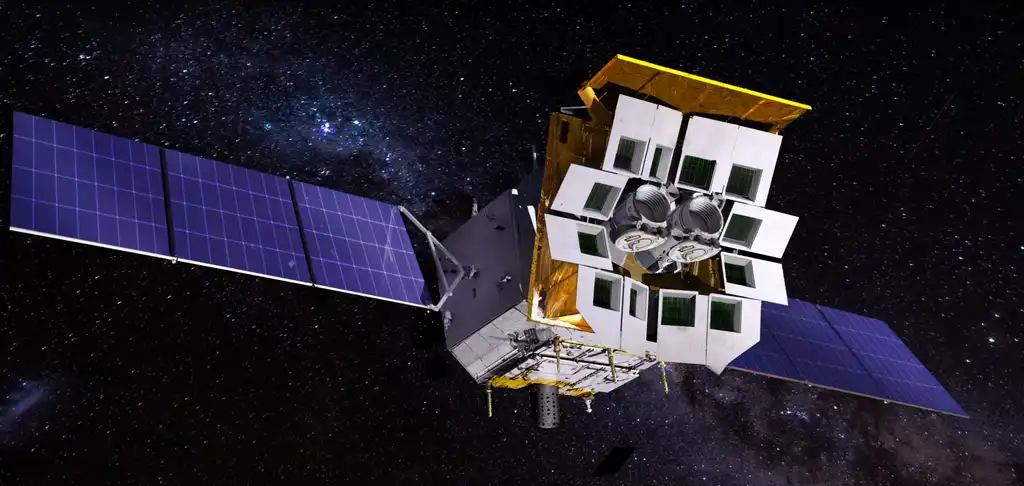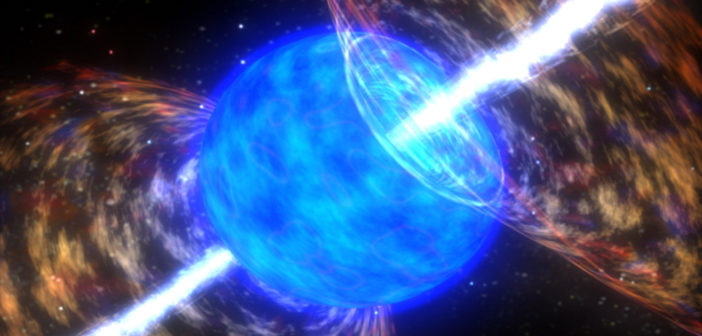NASA / SkyWorks Digital
Twelve years after they were first discovered, astronomers are coming to grips with fast X-ray transients (FXTs) — energetic explosions in the distant universe lasting from minutes to hours. At least some of them result from the explosive deaths of massive stars, as evidenced by follow-up observations of the most far-away FXT found to date.
In 2013, Peter Jonker (Radboud University, The Netherlands) found a short-lived X-ray burst in 13-year-old archival data from NASA’s Chandra X-ray Observatory. Over the next years, he and others found some 30 more. In some cases, the accurate Chandra positions coincided with distant galaxies, but the true nature of the bursts remained unknown.
The launch of the Chinese-European Einstein Probe, on January 9, 2024, changed all that. Its sensitive, wide-field X-ray cameras have registered more than 120 FXTs in the mission’s first 18 months. New discoveries are shared with the astronomical community within hours or even minutes, enabling follow-up observations using other facilities — a great example of multiwavelength astronomy.
On March 15, 2024, the Einstein Probe detected a 27-minute-long X-ray burst (EP240315a) in the constellation Hydra, the Water Snake, close to the bright star Achernar. Less than seven minutes after the X-ray onset, both the Swift and Konus-Wind satellites registered a 50-second-long gamma-ray burst, GRB240315C. Such “long” gamma-ray bursts are known to result from collapsars — the catastrophic explosions of extremely massive and rapidly rotating stars. Although a precise localization of the gamma-ray burst wasn’t possible, it was at least consistent with the sky position of the X-ray transient.
What’s more, less than an hour after the X-ray and gamma-ray bursts were detected, the Chilean station of the worldwide Asteroid Terrestrial-impact Last Alert System (ATLAS) telescope network imaged the area around Achernar, and spotted a new 19th-magnitude optical source, AT2024eju – most likely the burst’s afterglow. This find was reported about 24 hours after the initial discovery.
Within hours of that announcement, a team led by Jonker and his Radboud colleague Andrew Levan used the 10.4-meter Gran Telescopio Canarias (GTC) on La Palma, Spain, and the 8.2-meter European Very Large Telescope in Chile to obtain spectra of the fading optical source.
In a paper published in Nature Astronomy, the team report the burst’s light had traveled more than 12.5 billion years before arriving at Earth. As the radiation traveled through our expanding universe, both the burst’s wavelengths and its duration were stretched (effects known as redshift and time dilation, respectively) — so the X-rays originally had a much higher energy and a much shorter duration than was observed by the Einstein Probe.
“EP240315a is, convincingly, a fast X-ray transient associated with a gamma-ray burst,” says Joshua Bloom (University of California, Berkeley), who was not involved in the study. For a gamma-ray burst at such a great distance, “more energy observed in the X-rays for longer times is natural, due to the redshift and time dilation effect,” he adds.
So are all FXTs related to massive stars exploding as GRBs? No, says Jonker. While additional examples of FXT-GRB associations have been found since the discovery of this one, some of the Einstein Probe’s X-ray transients have quite different properties. For instance, “dark” FXTs have no gamma-ray, visible-light, or infrared counterparts at all. Others last for weeks and are relatively bright at visible and radio wavelengths, as you would expect for tidal disruption events, in which a small star is devoured by a supermassive black hole.
“Just like the richness and diversity within the quasar and GRB classes came to reveal themselves over the years, so too are we seeing this with FXTs,” says Bloom. “As more Einstein Probe FXTs are discovered and studied, we will start to see the emergence of subclasses, associated with a wide variety of physical events.”

China News Service / CC BY 3.0
In the case of EP240315a — the first Einstein Probe X-ray transient with a measured redshift — there are two remaining mysteries.
First is the odd time delay between the X-rays and the gamma rays. No one really understands why or how the onset of the X-ray burst could occur almost seven minutes before the gamma-ray burst. According to Levan, “it’s unexpected, given what we think we know about the mechanisms that launch the powerful jets that are responsible for the gamma and X-ray emission.”
Gamma-ray bursts are known to produce energetic jets of particles moving at almost the speed of light, and Bloom suggests that the observed time delay could provide “an important clue into the orientation of the relativistic jet with respect to our line of sight.”
The second mystery is the substantial amount of ultraviolet light emitted by the burst’s afterglow. If the massive star died in a star-forming region, as you would expect, the surrounding neutral hydrogen gas would absorb most of the higher-energy radiation.
Who knows: The gamma-ray burst might not have been produced by a collapsar after all, but by the collision and subsequent merger of two compact neutron stars. Such merger events are known to occur well outside star forming regions, or even outside galaxies altogether, where less neutral hydrogen is present. While mergers of compact objects generally create shorter GRBs, with a duration of a few seconds at most, some recent results suggest that they can also produce longer events. (This one, GRB240315C, lasted for about eight seconds before its passage through the expanding universe stretched its duration to the 50 seconds measured at Earth.)
More detections of fast X-ray transients, both by Einstein Probe and by the European Space Agency’s future Advanced Telescope for High Energy Astrophysics (ATHENA), will hopefully help solve the complicated mystery of these enigmatic explosions. “Rapid follow-up observations have only become possible very recently,” says Jonker. “This is uncharted territory.”

